Havel continued to write however, with his works critical of the government now being distributed via underground channels across Czechoslovakia, and his reputation as a leading voice among dissident revolutionaries was now on the rise. He was the bold and brave enough to co-found the Committee for the Defense of the Unjustly Prosecuted in 1979, which led to constant government surveillance, questioning, arrests and multiple incarcerations. His longest stay in prison was from June of 1979 to January of 1984, 4 years and 7 months. As a writer, he naturally documented his confinement as a book of letters he wrote to his wife, "Letters to Olga".
In 1989, Havel, a passionate supporter of non-violent resistance, was a leading figure in the Velvet Revolution, which occurred from November 17th to December 29, 1989, during which student and citizen demonstrations against the ruling Communist Party took place, first in Prague and then later all across Czechoslovakia.
On November 17th, International Students Day, a peaceful demonstration of 15,000 students chanting anti-communist slogans was suppressed by riot police, spawning false rumors that one student had been killed. Students and theater employees and actors went on strike in protest of the violence, as posters were used to spread the word since the government controlled media would suppress any such stories.
Student demonstrators on International Students Day
The inaccurate reports of a student death having occurring on the 17th added to the unrest among the general population and the strike began to spread to other cities beyond Prague. Havel and other leaders of opposition groups established the Civic Forum on the 19th to unify the protestors and then call for the dismissal of those responsible for the violence of the 17th as well as the release of all political prisoners.
On the 20th, the Civic Forum added the abolition of the guarantee that the Communist Party would hold the ruling position of Czechoslovakia from the nation's constitution. At the same time, non-communist newspapers began publishing information which differed from that of the government controlled newspapers and the first mass demonstration, attended by 200,000 people, occurred in Prague, while other demonstrations began in Bratislava.
The first mass demonstration of the growing Velvet Revolution
On the following day, November 21st, the Prime Minister had his first official meeting with the Civic Forum and personally guaranteed no violence would be used against the demonstrators, which had now swollen to 500,000, but he went on to assure the group that he would also protect socialism without debate.
Organizers of the protests began to spread the word to factories to attract even more participants as the mass demonstrations, which were now becoming a daily occurrence in not only Prague, but in other cities as well. Calls for a nationwide, two-hour general strike were being called for on November 27th, as was the demand for the release of political prisoner Ján Čarnogurský. That night, hard line government officials called in a 4,000 member paramilitary organization to crush the protests, but called them off at the last moment, likely losing their last, best opportunity to remain in power.
The daily protests continued, now aided by increasing media coverage of the events which depicted the government in an unfavorable light. On the 23rd Čarnogurský was released and he would later go on to become the Prime Minister of Slovakia. Also on that same day, the Minister of Defense issued a statement in which he stated that the army would never undertake action against the Czechoslovak people, despite the military informing the communist leaders of it's readiness to do just that.
Demonstrators giving policemen flowers as the protests stayed non-violent
On the 24th the entire executive committee of the government resigned with a more moderate communist named the new General Secretary. Meanwhile, Havel appeared on television for the first time, addressing details of the planned general strike, which was now to be joined by Czechoslovak TV and Radio, which led to the editorial staff of various newspapers now joining the growing movement.
The 25th saw 800,000 protestors and the 26th saw the first meeting between the Prime Minister Ladislav Adamec and Havel, as the demonstrations continued to swell.
The anti-government protesters in Wenceslas Square
The planned two-hour general strike was supported by 75% of the population, which solidified the Civic Forum as the representative of the people in its dealings with the government. Also on the 27th, the Ministry of Culture released anti-Communist literature in libraries, effectively ending government censorship.
Two days later on the 29th, the demand for the removal of the declaration of the Communist Party's leading role from the constitution was met when the Federal Assembly abolished that particular constitutional article.
On December 10th, President Gustáv Husák swore in a new government, the first in 41 years not dominated by the Communist Party. 19 days later Havel was elected as the new president of Czechoslovakia in a unanimous vote of the Federal Assembly, bringing to an end the bloodless downfall of the Communist Party in Czechoslovakia. It was a role he insisted was more duty than aspiration.
Havel greeting the masses following his election in 1989
Havel's presidency was confirmed in a free election by the people in 1990 and one of his first acts was to grant a wide ranging amnesty which set many political prisoners free.
Havel and his supporters had peacefully brought to an end over four decades of communism in Czechoslovakia in a matter of a couple of weeks, but still had decades of communist rule to un-weave from the fabric of the country, as they converted the country into a free market society and integrated Czechoslovakia into the European and world community from which that had been so isolated.
In 1992, forces in the Slovak parliament adopted a Declaration of Independence of the Slovak nation, which would lead to the dissolution of Czechoslovakia, which Havel opposed. This opposition led to his resignation on July 20, 1992, as he did not want to preside over the breakup of his country. The peaceful separation into two distinct nations, known as the Velvet Divorce, occurred on January 1, 1993, giving birth to the new nations of the Czech Republic and Slovakia.
25 days later Havel was elected as the first president of the Czech Republic, a post he would hold until early 2003 after serving two terms in office, during which his health began to be an issue, having previously had two bouts with lung cancer in the late 1990's.
In 1998, the Czech Republic, following their 1-0 win over Russia on a lone goal by Petr Svoboda, emerged victorious from the first Olympic Games to feature the stars of the NHL competing for their home countries.
Dominik Hasek stole the show in Nagano
Following the gold medal game, Havel, in attendance in Japan, visited the locker room of the victorious team to invite them all to his home for a party in celebration.
"He was there and after the game, we all flew to his house," Jaromir Jagr recalled. "He wanted all the team there. It was fun. Big house."
Jagr is congratulated by Havel following the 1998 Olympic victory
"If you look at the big picture, he was the main guy. Without him, nobody would play in the NHL from the Czech unless you defect. After the revolution, which he started, the borders were open and there was freedom. You could go anywhere you want." Jagr said.
Martin Rucinsky presents Havel with a jersey after the 1998 Olympic victory
Jagr had been to the White House with Havel on three occasions, including the time Havel was honored with the Presidential Medal of Freedom in 2003.
Havel, President Bill Clinton and Jagr at the White House
After leaving the presidency, Havel continued his humanitarian works as well as staying active in the theater, which included the first complete festival of his plays, which was held in New York City in celebration of his 70th birthday. He also wrote his first new play in 18 years, "Leaving", which was published in November of 2007, later directing a film version of it which premiered in March of 2011.
Havel passed away on December 18, 2011, which elicited numerous tributes from leaders all over the globe.
Today's featured jersey is a 1991-92 Czechoslovakia National Team Richard Král jersey. Tackla was the sole supplier of jerseys to IIHF tournaments in the late 1980's and early 1990's. Their dye-sublimation process allowed for bright colors and bold designs not seen before. This is a surprisingly vibrant a flashy design, particularly for a staid communist country generally known for it's spartan and utilitarian designs. This waving flag effect was a foreshadowing of the bold Nike jerseys later worn at the 1996 World Cup of Hockey.
This was the final style of jersey worn by Czechoslovakia before the the division of the country into the Czech Republic and Slovakia. For the 1993 international season, the Czechs wore an identical jersey, only now with the main crest replaced by the Czech coat of Arms.
Czechoslovakia was founded at the conclusion of World War I and was divided up during World War II essentially between Germany and Hungary. The country was re-established at the conclusion of World War II and in February of 1948, power was seized by the Communists. During a brief period of liberalization in 1968 known as the Prague Spring, five countries, led by the Soviet Union, invaded Czechoslovakia to restore and maintain the Communist system and ideals. It is because of this invasion in 1968, also the year in which his grandfather died in prison, that Jagr wears #68.
Czechoslovakia played their first game of international hockey at the 1920 Winter Olympics in Antwerp, Belgium, a 15-0 loss to Canada. The program would improve quickly, as they would record their largest margin of victory ever by 1939 in a 24-0 defeat of Yugoslavia, later matched several times in a 24-0 win over Belgium in 1947, a 27-3 drubbing of East Germany in 1951 and a 25-1 win over Japan in 1957.
Czechoslovakia would win the Olympic silver medal four times, in 1948, with gold going to Canada, and then again in 1968, 1976 and 1984, each time as runner up to the powerful Soviet Union. When they weren't winning silver, they were generally in contention, with bronze medals in 1920, 1964, 1972 and 1992.
They would also participate in five Canada Cups, with their best showing being second in the inaugural 1976 tournament.
They also had a long and successful history of competing at the World Championships, dating back to 1930, with six gold medals to their credit, which they won in 1947, 1949, 1972, 1976, 1977 and 1985 with 10 silver and 14 bronze to go along with their championships. They were the only country to break the stranglehold of the Soviet Union during the 24 years from 1963 to 1986, taking great delight at defeating their main rivals four times during the main era of Soviet dominance.
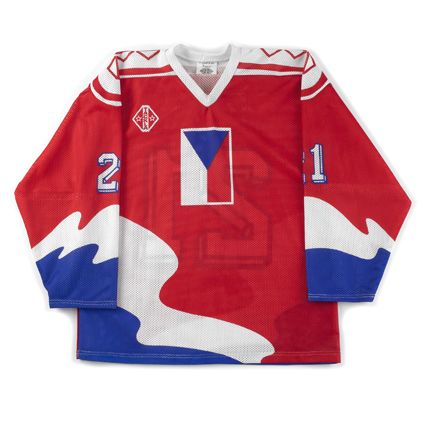
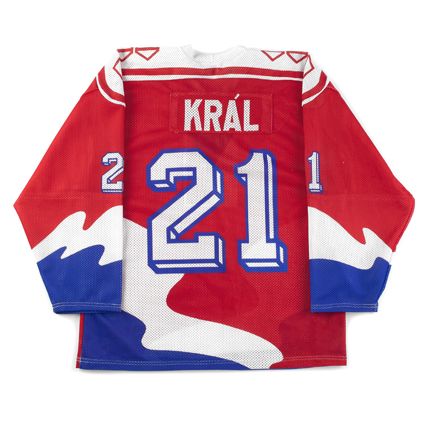
Bonus jersey: Today's bonus jersey is a 1996 Czech Republic National Team Robert Reichel jersey as
worn when the Czech Republic captured their first gold medal as an
independent nation in 1996, in only their fourth year of play.
The Czechs
won Group 2 with a 4-0-1 record, defeating Sweden and Finland in the
process. They defeated Germany in the Quarterfinals 6-1
before dominating the United States 5-0 in the Semifinals. They drew
Canada in the final and a dramatic goal by Martin Prochazka with 19
seconds remaining gave them a 3-2 lead before an empty net goal made for
a 4-2 final score and their first World Championship as the Czech
Republic.
This classically styled jersey was worn only once by the Czech Republic
and resulted in a World Championship, making it a great combination of
being both rare and historically desirable. Following the World Championships, the Czechs
changed to the new "waving flag" style for the 1996 World Cup of Hockey
later that fall.
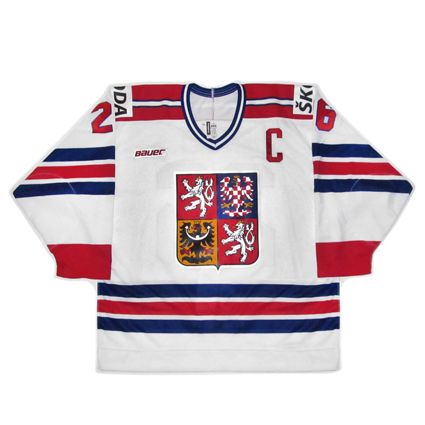
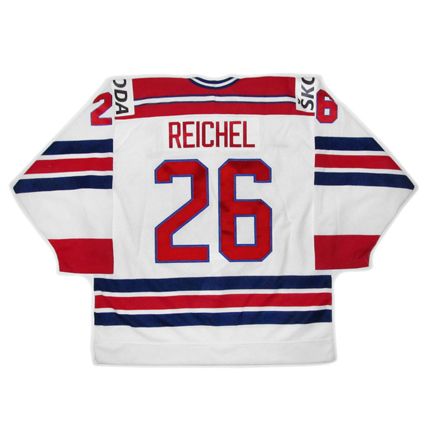
Extra bonus jersey: Today's extra bonus jersey is a 1998 Czech Republic National Team Dominik Hasek jersey as
worn when the Czech Republic captured the Olympic gold medal in Nagano,
Japan. This bold style of jersey was first worn in the 1998 Olympics
and is associated with a golden era of Czech hockey, having been worn
not only for the Olympic gold in 1998, but also for three consecutive
World Championship gold medals in 1999, 2000 and 2001.
The
Olympics in 1998 were the first with the full participation of NHL
players, as the league suspended it's regular season schedule for the
occasion, but the
Czechs had the fewest NHL players on it's roster among the top six
nations with 11.
They got off to a good start by shutting out Finland 3-0 in
their first game before demolishing Kazakhstan 8-2. They lost to Russia
2-1 in group play, but then bounced back with an easy 4-1 win to
eliminate the Americans.
The
semi-finals saw them matched up against Canada, a hard fought game that
ended with a memorable shootout, as Hasek stonewalled all five Canadian
shooters to advance to the gold medal game and a rematch against Russia.
Defenseman Svoboda
scored the only goal of the contest at 8:08 of the third period as
Hasek shut out the Russians to conclude the tournament with an amazing 6
goals allowed in 6 games against the top professionals from Finland,
the United States, Canada and Russia - twice - to finish with a goals
against average of 0.97.
After
the medal ceremony, Hasek said, "When I saw the flag go up, I saw my
whole career flash before my eyes from the first time my parents took me
to a hockey game until now."
Today's video section begins with Amnesty International's Steve Crenshaw paying tribute to Havel.
Next are news reports aired during the Velvet Revolution.


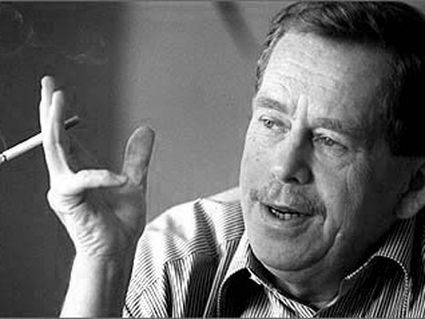
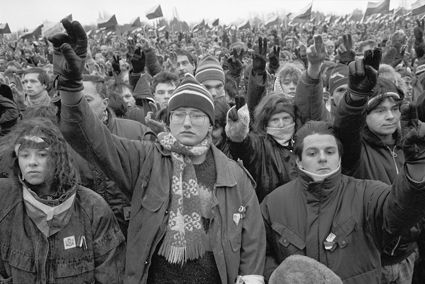
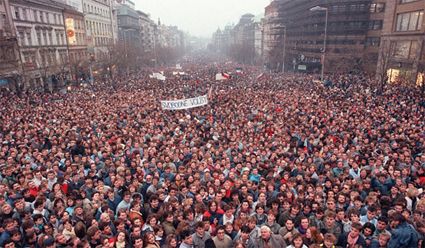
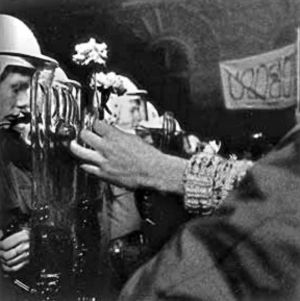
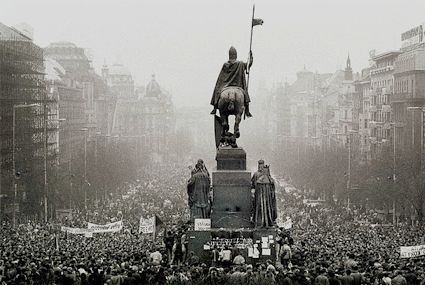
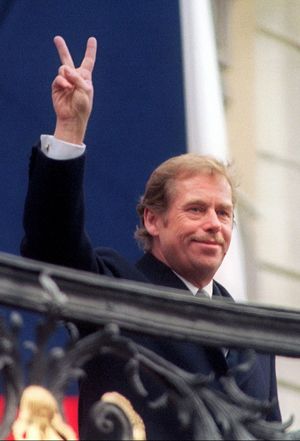
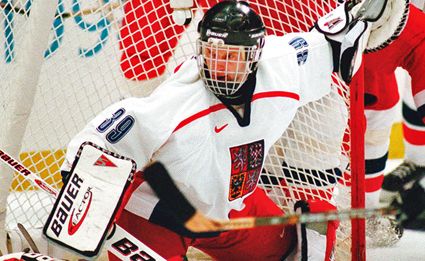
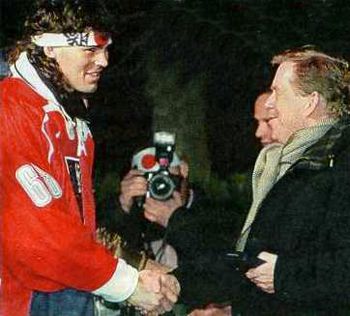
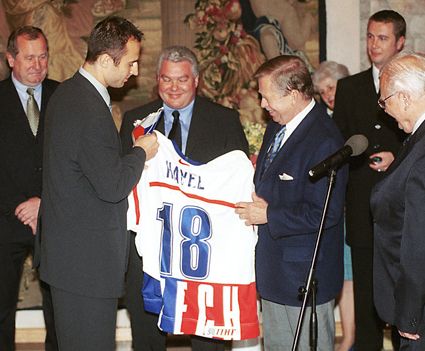

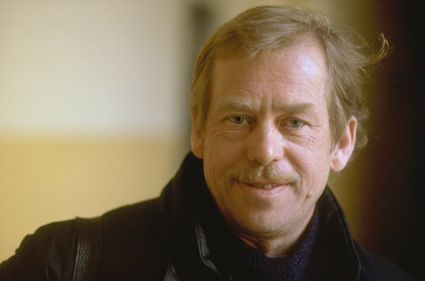




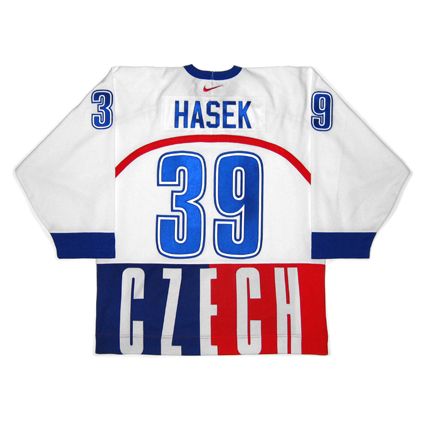










No comments:
Post a Comment
We welcome and encourage genuine comments and corrections from our readers. Please no spam. It will not be approved and never seen.